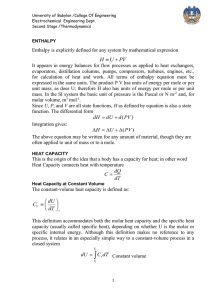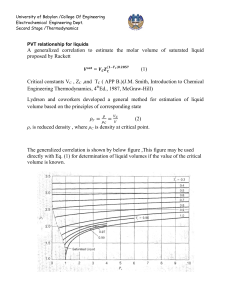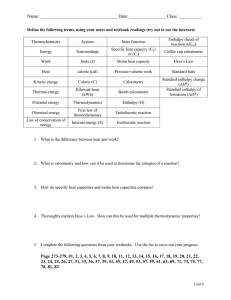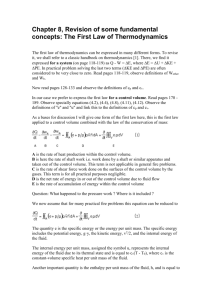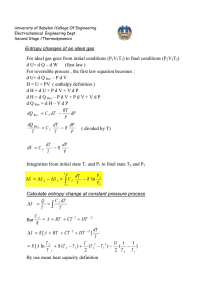University of Babylon /College Of Engineering Electrochemical Engineering Dept.
advertisement
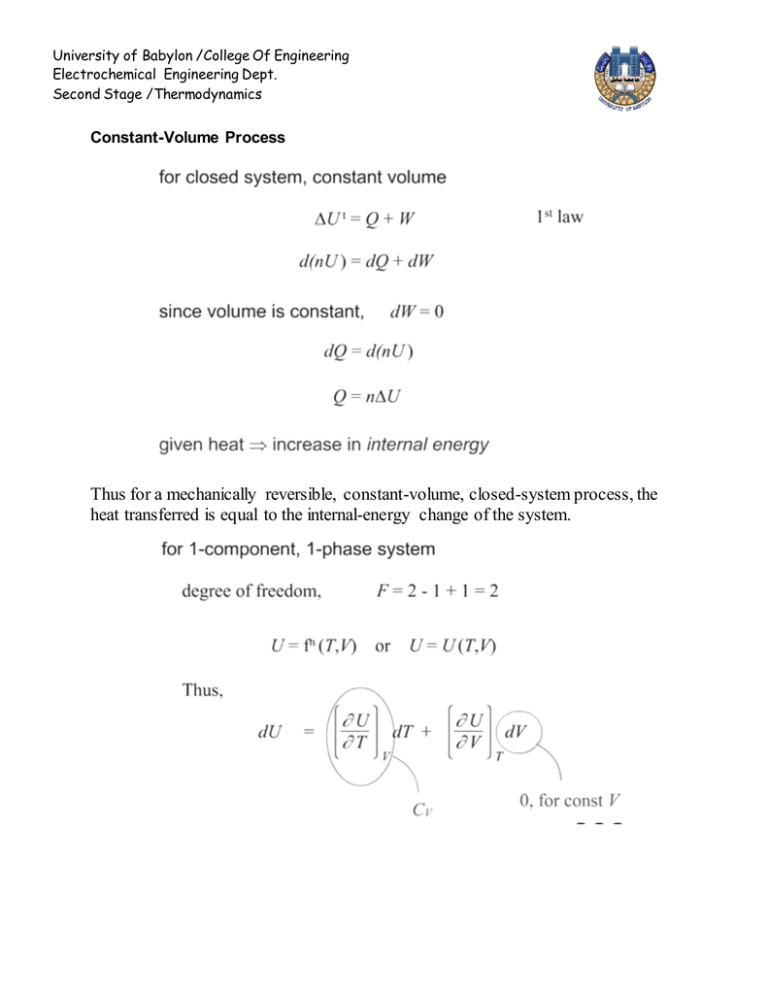
University of Babylon /College Of Engineering Electrochemical Engineering Dept. Second Stage /Thermodynamics Constant-Volume Process Thus for a mechanically reversible, constant-volume, closed-system process, the heat transferred is equal to the internal-energy change of the system. University of Babylon /College Of Engineering Electrochemical Engineering Dept. Second Stage /Thermodynamics Constant-Pressure Process the appearance of (U +PV ) group suggests as a new thermodynamic property define enthalpy .Thus for a mechanically reversible, constant-pressure, closedsystem process, the heat transferred equals the enthalpy change of the system. University of Babylon /College Of Engineering Electrochemical Engineering Dept. Second Stage /Thermodynamics ENTHALPY Enthalpy is explicitly defined for any system by mathematical expression H U PV It appears in energy balances for flow processes as applied to heat exchangers, evaporators, distillation columns, pumps, compressors, turbines, engines, etc., for calculation of heat and work. All terms of enthalpy equation must be expressed in the same units. The product P V has units of energy per mole or per unit mass, as does U; therefore H also has units of energy per mole or per unit mass. In the SI system the basic unit of pressure is the Pascal or N m-2 and, for molar volume, m3 mol-1. Since U, P, and V are all state functions, H as defined by equation is also a state function. The differential form dH dU d (PV ) Integration gives : H U (PV ) The above equation may be written foe any amount of material , though they are often applied to unit of mass or to a mole. Example Calculate ∆U and ∆H for 1Kg water vaporized at constant temperature and pressure ( 100○ C , 101.33 KPa) the specific volumes of liquid and vapor water at these condition are 0.00104 and 1.673 m 3 kg -1 ,for this change , heat in the amount of 2,256.9 kJ is added to water. W= P∆V = 101.33 kPa × ( 1.673 – 0.001) m 3 = 169.4 kJ U Q W 2,256.9 – 169.4 = 2.087.5 kJ With P constant : H U PV But P∆V = W H U W Q 2,2256.9kJ HEAT CAPACITY This is the origin of the idea that a body has a capacity for heat ,in other word Heat Capacity connects heat with temperature dQ C dT University of Babylon /College Of Engineering Electrochemical Engineering Dept. Second Stage /Thermodynamics Heat Capacity at Constant Volume The constant-volume heat capacity is defined as: dU CV dT v This definition accommodates both the molar heat capacity and the specific heat capacity (usually called specific heat), depending on whether U is the molar or specific internal energy. Although this definition makes no reference to any process, it relates in an especially simple way to a constant-volume process in a closed system T2 dU Cv dT constant volume T1 T2 Integration yields: U Cv dT T1 For constant volume process Q = n ∆U T2 Q n Cv dT T1 Heat Capacity at Constant Pressure The constant-volume heat capacity is defined as: dU CP dT P This heat capacity relates in an especially simple way to a constant-pressure, closed-system process, dH CP dT H T2 C P dT T1 For a mechanically reversible, constant-pressure process, Q = n ∆H T2 Q n C P dT T1
